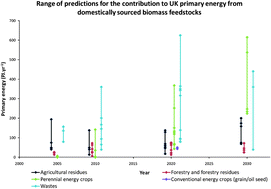Estimating bio-energy resource potentials to 2050: learning from experience†
Abstract
Using the United Kingdom as a case study, this article examines the most important assumptions and uncertainties that affect estimates of future biomass availability. The UK is interesting because it has been identified as a European exemplar for its efforts to understand its domestic biomass resource. Comparing estimates, we find that the high level assumptions are remarkably consistent and conservative. There are also generic methodological problems that need to be overcome; specifically inconsistent definitions of resource potential and discrepancies in the scope of, and extent of, resource inventories. We find that the total contribution of bio-energy to UK primary energy in ∼2030 ranges from 400 to 1100 PJ yr−1 (4–11% of UK primary energy cf. 2008), but that all constraints must be removed for the higher estimate to be achieved. We conclude that existing studies are imperfect, but that they exhaust the availability and quality of the underlying data. Consequently, increasing the precision of estimates would require a major new data collection effort. We also consider that the dominant assumption that bio-energy can only proceed with negligible impact on other markets is untenable and merits further investigation.


 Please wait while we load your content...
Please wait while we load your content...